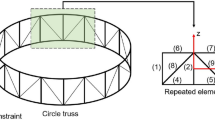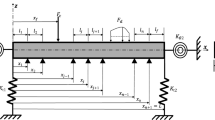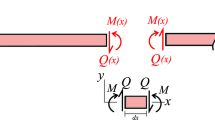Abstract
Purpose
To overcome the influence of supporting stiffness and realize the consistency of modal results between ground tests and its space missions, a new supporting method for modal test of a geometrical pneumatic quasi-zero-stiffness (PQZS) system is proposed based on the dynamic characteristics of rolling lobe air-springs and dipteran mechanism.
Methods
First, the dynamic model is constructed for a multiple-span Euler–Bernoulli beam with concentrated mass supported by the PQZS system according to the Second Newton’s Law. Moreover, the modal analysis is carried out theoretically via transformation matrix, the Galerkin and the averaging method for the first four orders including mode shapes, frequencies and its bifurcation with different supporting parameters. Meanwhile, based on the general single-freedom system for modal 1, the dynamic behaviors are also investigated including bifurcation, chaos and co-existing periodic solutions theoretically and numerically by Melnikov and the forth order Runge–Kutta method. Furthermore, a modal analysis system is set up to verify the performance of PQZS supports experimentally.
Results
The theoretical analysis shows the modalities obtained from PQZS supports is more consistent with free-constraint condition than linear supports with an easy requirement about assembling position. The system will vibrate in chaotic state through subharmonic and double-periodic bifurcation for the general single-freedom system of modal 1. The experimental results also indicate the more accurate results can be obtained by PQZS supports which is agree with the modalities under free-constraint condition than linear boundary.
Conclusion
The findings in this work illustrate a better performance of PQZS supporting system for modal test than traditional ways especially in low-order modalities, which can realize consistency of modal results between ground tests and its space missions, and provide reference for engineering application.



















Similar content being viewed by others
References
He S, Tang T, Xu E et al (2020) Vibration control analysis of vehicle steering system based on combination of finite-element analysis and modal testing. J Vib Control 26:88–101
Chen G, Wu Z, Gong C et al (2020) DIC-based operational modal analysis of bridges. Adv Civ Eng 39:1–13
Chen G, Chen X, Omenzetter P (2020) Modal parameter identification of a multiple-span post-tensioned concrete bridge using hybrid vibration testing data. Eng Struct 39:1667–1694
Gara F, Nicoletti V, Carbonari S et al (2020) Dynamic monitoring of bridges during static load tests: influence of the dynamics of trucks on the modal parameters of the bridge. J Civ Struct Health Monit 10:197–217
Han Z, Brownjohn JMW, Chen J (2020) Structural modal testing using a human actuator. Eng Struct 221:1667–1694
Liu H, Dong S, Liang H (2019) Modal testing and detection of pretension deviation in a cable dome structure. Adv Struct Eng 22:413–426
Viviescas Jaimes Á, Vargas Carvajal LA (2019) Riveros Jerez C A Identificación modal de un puente viga cajón usando mediciones óptimamente seleccionadas de ensayosde excitación ambiental,. Revista UIS Ingenierías 18:31–40
Castellanos-Toro S, Marmolejo M, Marulanda J et al (2018) Frequencies and damping ratios of bridges through operational modal analysis using smartphones. Constr Build Mater 188:490–504
Shi-yao Z, Dong-xu L, Yong-jun L et al (2021) Effect of drive control on dynamic characteristics of spacecraft tracking-drive flexible systems. Mech Syst Signal Process 150:107352–107373
Karaağaçlı T, Özgüven HN (2021) Experimental modal analysis of nonlinear systems by using response-controlled stepped-sine testing. Mech Syst Signal Process 146:107023–107046
Habaka MA, Farag SS, Khalil M et al (2020) Experimental and computational dynamic structural analysis of free-flight rockets, IOP conference series. Mater Sci Eng 973:1–7
Feng S, H Y, Wen Y (2017) Application of free interface modal synthesis method on modal test boundary transformation of one missile. In: 2017 3rd international conference on applied mechanics and mechanical automation, 2017, pp 57–61
Lu W, Du X, Zeng C (2017) Application of hammering method modal testing in larger structure (2017). In: 2017 international conference on computer systems, electronics and control (ICCSEC), 2017, pp 188–192
Pandit JK, Mahapatra DR, Pandiyan R (2016) Modal analysis of power electronics module of spacecraft and its health monitoring—an approach. Procedia Eng 144:283–288
Coppotelli G, Grappasonni C, Di Trapani C (2013) Operational modal analysis of a solid rocket motor from firing test. J Spacecr Rockets 50:632–640
Chen G, Omenzetter P, Beskhyroun S (2017) Operational modal analysis of an eleven-span concrete bridge subjected to weak ambient excitations. Eng Struct 151:839–860
Ni Y, Zhang F, Xia Y et al (2015) Operational modal analysis of a long-span suspension bridge under different earthquake events. Earthq Struct 8:859–887
Altunisik AC, Bayraktar A, Sevim B (2013) Analytical and experimental modal analyses of a highway bridge model. Comput Concrete 12:803–818
Igolkin AA, Safin AI, Filipov AG (2018) Modal analysis of the dynamic mockup of AIST-2D small spacecraft, VESTNIK of Samara University. Aerosp Mech Eng 17:100–108
Igolkin AA, Safin AI, Prokofiev AB (2018) Modal analysis of space-rocket equipment components, IOP conference series. Mater Sci Eng 302:1–7
Xia JN, Song HW (2017) Modal parameter identification of structure under base excitation using vibration test data. Proc Inst Mech Eng Part G J Aerosp Eng 231:1428–1450
Wickramasinghe V, Chen Y, Zimcik D et al (2013) Modal survey test and model correlation of the CASSIOPE spacecraft. Exp Tech 37:15–23
Jang Y, Soon-Hong P, Moo YY (2004) Modal test of EM and modal analysis of FM for KSR-III. J Korean Soc Aeronat Space Sci 32:95–102
Bouna HS, Nbendjo BRN, Woafo P (2020) Isolation performance of a quasi-zero stiffness isolator in vibration isolation of a multi-span continuous beam bridge under pier base vibrating excitation. Nonlinear Dyn 100:1125–1141
Anague Tabejieu LM, Nana Nbendjo BR, Filatrella G (2019) Effect of the fractional foundation on the response of beam structure submitted to moving and wind loads. Chaos Solitons Fractals 127:178–188
Wang Y, Fang Z (2015) Vibrations in an elastic beam with nonlinear supports at both ends. J Appl Mech Tech Phys 56:337–346
Ding H, Li Y, Chen L (2019) Nonlinear vibration of a beam with asymmetric elastic supports. Nonlinear Dyn 95:2543–2554
Heertjes MF, Van De Molengraft MJG (2001) Controlling the nonlinear dynamics of a beam system. Chaos Solitons Fractals 12:49–66
Ndemanou BP, Chamgoué AC, Kol GR et al (2021) High static low dynamic stiffness outriggers effects on vibration control on cantilever Timoshenko Beam under earthquake excitation. SN Appl Sci 3:1–12
Mao X, Ding H, Chen L (2017) Vibration of flexible structures under nonlinear boundary conditions. J Appl Mech 84:1–11
Ding H, Chen L (2019) Nonlinear vibration of a slightly curved beam with quasi-zero-stiffness isolator. Nonlinear Dyn 95:2367–2382
Ding H, Lu Z, Chen L (2019) Nonlinear isolation of transverse vibration of pre-pressure beams. J Sound Vib 442:738–751
Ding H, Zhu M, Chen L (2018) Free and forced nonlinear vibration of a transporting belt with pulley support ends. Nonlinear Dyn 92:2037–2048
Ding H, Zhu M, Chen L (2019) Dynamic stiffness method for free vibration of an axially moving beam with generalized boundary conditions. Appl Math Mech 40:911–924
Zhang T, Ouyang H, Zhang YO et al (2016) Nonlinear dynamics of straight fluid-conveying pipes with general boundary conditions and additional springs and masses. Appl Math Model 40:7880–7900
Özkaya E, Sarigül M, Boyaci H (2009) Nonlinear transverse vibrations of a slightly curved beam carrying a concentrated mass. Acta Mech Sin 25:871–882
Roncen T, Sinou J, Lambelin J (2017) Experiments and numerical simulations of nonlinear vibrations of a beam with non-ideal boundary conditions and uncertainties. Procedia Eng 199:808–813
Krysko VA, Awerejcewicz J (2005) On the vibration of the euler-bernoulli beam with clamped ends deflection constraints. Int J Bifurc Chaos 5:1867–1878
Lv B, Li W, Ouyang H (2015) Moving force-induced vibration of a rotating beam with elastic boundary conditions. Int J Struct Stab Dyn 15:1–24
Rincón-Casado A, González-Carbajal J, García-Vallejo D et al (2021) Analytical and numerical study of the influence of different support types in the nonlinear vibrations of beams. Eur J Mech A Solids 85:1–13
Li S, Reynders E, Maes K et al (2013) Vibration-based estimation of axial force for a beam member with uncertain boundary conditions. J Sound Vib 332:795–806
Liu M, Cao D, Zhu D (2021) Equivalent dynamic model of the space antenna truss with initial stress. AIAA J 58:1851–1863
Liu M, Cao D, Zhang X et al (2021) Nonlinear dynamic responses of beamlike truss based on the equivalent nonlinear beam model. Int J Mech Sci 194:1–14
Zhang SY, Sheng X, Jiang JZ et al (2021) Vibration suppression of bridges under moving loads using the structure-immittance approach. Int J Mech Sci 211:1–12
Jabłonka A, Iwankiewicz R (2021) Dynamic response of a beam to the train of moving forces driven by an Erlang renewal process. Probab Eng Mech 66:1–12
Zangeneh A, Museros P, Pacoste C et al (2021) Free vibration of viscoelastically supported beam bridges under moving loads: closed-form formula for maximum resonant response. Eng Struct 224:1–11
Yang T, Cao Q, Hao Z (2021) A novel nonlinear mechanical oscillator and its application in vibration isolation and energy harvesting. Mech Syst Singal Process 155:1–20
Yang T, Zhou S, Fang S, Qin W et al (2021) Nonlinear vibration energy harvesting and vibration suppression technologies: designs, analysis and applications. Appl Phys Rev 8:1–31
Yang T, Cao Q, Li Q et al (2021) A multi-directional multistable device: modeling, experiment verification and applications. Mech Syst Singal Process 146:1–24
Acknowledgements
The authors acknowledge the support from the major project of Natural Science Foundation of China under Grant No.11732006, and the CALT Foundation of Beijing Institute of Structure and Environmental Engineering (CALT201808).
Author information
Authors and Affiliations
Corresponding author
Ethics declarations
Conflict of interest
The authors declare that they have no conflict of interest.
Additional information
Publisher's Note
Springer Nature remains neutral with regard to jurisdictional claims in published maps and institutional affiliations.
Appendix A: Expression for Some Matrix in the Text
Appendix A: Expression for Some Matrix in the Text
where: \(t_{11}=\cos \left( {{p}_{n}}{{l}_{k}} \right) +\frac{{{k}_{1}}}{2{{k}^{3}}}\sin \left( {{p}_{n}}{{l}_{k}} \right),\) \({t_{12}}=-\sin \left( {{p}_{n}}{{l}_{k}} \right) +\frac{{{k}_{1}}}{2{{p}^{3}}}\cos \left( {{p}_{n}}{{l}_{k}} \right),\) \(t_{13}=\frac{{{k}_{1}}}{2{{p}^{3}}}\sinh \left( {{p}_{n}}{{l}_{k}} \right),\) \(t_{14}=\frac{{{k}_{1}}}{2{{p}^{3}}}\cosh \left( {{p}_{n}}{{l}_{k}} \right),\) \(t_{21}=\sin \left( {{p}_{n}}{{l}_{k}} \right),\) \(t_{22}=\cos \left( {{p}_{n}}{{l}_{k}} \right),\) \(t_{31}=-\frac{{{k}_{1}}}{2{{p}^{3}}}\sin \left( {{p}_{n}}{{l}_{k}} \right),\) \(t_{32}=-\frac{{{k}_{1}}}{2{{p}^{3}}}\cos \left( {{p}_{n}}{{l}_{k}} \right),\) \(t_{33}=\cosh \left( {{p}_{n}}{{l}_{k}} \right) -\frac{{{k}_{1}}}{2{{p}^{3}}}\sinh \left( {{p}_{n}}{{l}_{k}} \right),\) \(t_{34}=\sinh \left( {{p}_{n}}{{l}_{k}} \right) -\frac{{{k}_{1}}}{2{{p}^{3}}}\cosh \left( {{p}_{n}}{{l}_{k}} \right),\) \(t_{43}=\sinh \left( {{p}_{n}}{{l}_{k}} \right),\) \(t_{44}=\cosh \left( {{p}_{n}}{{l}_{k}} \right).\)
where: \(U_{11}=-\sin \left( {{p}_{n}}{{l}_{k+1}} \right),\) \(U_{12}=-\cos \left( {{p}_{n}}{{l}_{k+1}} \right),\) \(U_{13}=\sinh \left( {{p}_{n}}{{l}_{k+1}} \right),\) \(U_{14}=\cosh \left( {{p}_{n}}{{l}_{k+1}} \right),\) \(U_{21}=-{{p}_{n}}^{3}\cos \left( {{p}_{n}}{{l}_{k+1}} \right) +m{{\omega }^{2}}\sin \left( {{p}_{n}}{{l}_{k+1}} \right),\) \(U_{22}={{p}_{n}}^{3}\sin \left( {{p}_{n}}{{l}_{k+1}} \right) + m{{\omega }^{2}}\cos \left( {{p}_{n}}{{l}_{k+1}} \right),\) \(U_{23}={{p}_{n}}^{3}\cosh \left( {{p}_{n}}{{l}_{k+1}} \right) +m{{\omega }^{2}}\sinh \left( {{p}_{n}}{{l}_{k+1}} \right),\) \(U_{24}={{p}_{n}}^{3}\sinh \left( {{p}_{n}}{{l}_{k+1}} \right) +m{{\omega }^{2}}\cosh \left( {{p}_{n}}{{l}_{k+1}} \right).\)
Rights and permissions
About this article
Cite this article
Zhang, X., Cao, Q. & Huang, W. Dynamic Analysis of a Multiple-Span Euler–Bernoulli Beam Supported by Pneumatic Quasi-zero-stiffness System. J. Vib. Eng. Technol. 10, 1349–1367 (2022). https://doi.org/10.1007/s42417-022-00451-w
Received:
Revised:
Accepted:
Published:
Issue Date:
DOI: https://doi.org/10.1007/s42417-022-00451-w




